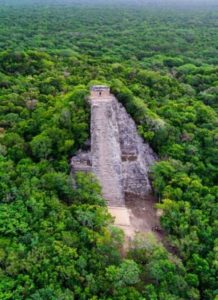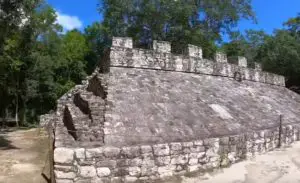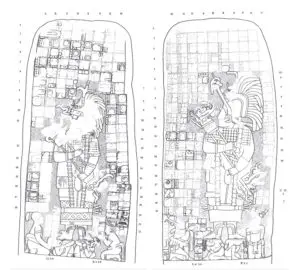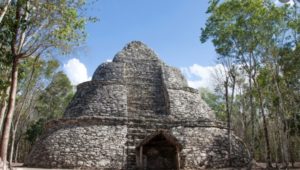Podcast: Play in new window | Download
Subscribe: Apple Podcasts | RSS
 In the year 1894, 27-year-old Thomas Gann was excited to leave England to start an exhilarating new chapter in his life. The young medical doctor had just been appointed Chief Medical Officer of British Honduras; a colonial backwater of the British Empire in Central America now known as the independent nation of Belize. In his spare time, Dr. Gann explored the Mayan ruins in the interior of the colony which were rarely visited by outsiders. His enthusiasm took him across the undefined border with Mexico and he spent years visiting ruined sites in both British and Mexican territory. Dr. Gann regularly returned to England to give lectures on his findings and cultivated sponsors for dozens of jungle expeditions. One important journey was to the lost city of Cobá which is located in the modern Mexican state of Quintana Roo on the Yucatán Peninsula just 75 miles southwest of the popular tourist destination of Cancún. In Dr. Gann’s time, the site, with some of the largest structures in the Maya world, had been seldom visited and was little known by the outside world. The first mention of it anywhere occurred in 1842 when American explorer John Lloyd Stephens documented that he had heard about the massive ruins in the forest from a Spanish priest in a nearby village, but it was too difficult to get to. The next report of the existence of Cobá was 40 years later in September of 1882 when Juan Peón Contreras, the director of the Museum of Yucatán arrived at the site for the first modern-era exploration. For much of the latter half of the 1800s, the area was a dangerous place for outsiders and archaeological expeditions were put on hold due to the ongoing Caste War that inflamed the region for most of that time. The only other documented visitor to the Cobá ruins in the 19th Century was Teoberto Maler in the year 1893. Maler was a German man who served in the Mexican army under the European emperor of Mexico Maximilian some 30 years before visiting the ruins. Maler would take the first photographs of Cobá but his notes and pictures would not be discovered until many years after his expedition. When the English doctor Thomas Gann arrived at Cobá in February of 1926 it had not been visited by outsiders for well over 30 years. Some of the jungle cleared by Contreras and Maler had already grown back. The doctor went about clearing the vegetation, digging, and documenting a great wealth of discoveries at this rather large Maya site. In the 1930s and 1940s Cobá saw a flurry of archaeological activity, mostly from the French and the Americans. A notable researcher was the famous Mayanist Michael Coe who first visited the site when he was a graduate student at Harvard. Cobá was ignored by the outside world for another 30 years until the building of the resort city of Cancún in the early 1970s. With the Mexican government wishing to promote tourism in the adjacent Maya sites, a road was built to Cobá and serious restoration of the site began.
In the year 1894, 27-year-old Thomas Gann was excited to leave England to start an exhilarating new chapter in his life. The young medical doctor had just been appointed Chief Medical Officer of British Honduras; a colonial backwater of the British Empire in Central America now known as the independent nation of Belize. In his spare time, Dr. Gann explored the Mayan ruins in the interior of the colony which were rarely visited by outsiders. His enthusiasm took him across the undefined border with Mexico and he spent years visiting ruined sites in both British and Mexican territory. Dr. Gann regularly returned to England to give lectures on his findings and cultivated sponsors for dozens of jungle expeditions. One important journey was to the lost city of Cobá which is located in the modern Mexican state of Quintana Roo on the Yucatán Peninsula just 75 miles southwest of the popular tourist destination of Cancún. In Dr. Gann’s time, the site, with some of the largest structures in the Maya world, had been seldom visited and was little known by the outside world. The first mention of it anywhere occurred in 1842 when American explorer John Lloyd Stephens documented that he had heard about the massive ruins in the forest from a Spanish priest in a nearby village, but it was too difficult to get to. The next report of the existence of Cobá was 40 years later in September of 1882 when Juan Peón Contreras, the director of the Museum of Yucatán arrived at the site for the first modern-era exploration. For much of the latter half of the 1800s, the area was a dangerous place for outsiders and archaeological expeditions were put on hold due to the ongoing Caste War that inflamed the region for most of that time. The only other documented visitor to the Cobá ruins in the 19th Century was Teoberto Maler in the year 1893. Maler was a German man who served in the Mexican army under the European emperor of Mexico Maximilian some 30 years before visiting the ruins. Maler would take the first photographs of Cobá but his notes and pictures would not be discovered until many years after his expedition. When the English doctor Thomas Gann arrived at Cobá in February of 1926 it had not been visited by outsiders for well over 30 years. Some of the jungle cleared by Contreras and Maler had already grown back. The doctor went about clearing the vegetation, digging, and documenting a great wealth of discoveries at this rather large Maya site. In the 1930s and 1940s Cobá saw a flurry of archaeological activity, mostly from the French and the Americans. A notable researcher was the famous Mayanist Michael Coe who first visited the site when he was a graduate student at Harvard. Cobá was ignored by the outside world for another 30 years until the building of the resort city of Cancún in the early 1970s. With the Mexican government wishing to promote tourism in the adjacent Maya sites, a road was built to Cobá and serious restoration of the site began.
 Archaeologists believe that Cobá was founded sometime around 300 BC and had purely agricultural beginnings. The Pre-Classic Maya built a small town at the site most likely to take advantage of two permanent local water sources, Lake Macanxoc and Lake Cobá and two smaller ponds. The word Cobá means “Rippling Waters,” and this was the name the ancients themselves used for the site. As an aside, many names of modern Maya ruins are latter-day creations or interpretations of what the original names could have been. This site was known as Cobá, “The Place of Rippling Waters,” since its very founding in first centuries BC. Due to rich soils and good sources of water, the early farming community flourished. By around 100 AD, building in stone began at the site and the archaeological evidence shows that the population increased greatly. With the rise in population came craft specialization and a well-defined social hierarchy. By 200 AD Cobá had become a regional power. The rulers of Cobá controlled local trade networks, exacted tribute from nearby towns and villages, and constructed the ports of Tulum and Xel Há on the Caribbean. From its ports Cobá traded with other Maya cities up and down the eastern coast of Mexico and Central America. Some researchers theorize that the Cobá seafaring traders made it as far as Cuba and perhaps even to Florida. For more information about the possible ancient Mayan connection to Florida, please see Mexico Unexplained episode number 177. https://mexicounexplained.com/did-the-ancient-maya-colonize-florida/ The ruling elite of Cobá constructed many sacbes, or elevated stone pathways that not only connected the residential areas within the city but radiated outward to connect the city to other settlements that were either tied to Cobá politically or through trade. There were at least 16 of these roads that went many miles beyond the city limits. The longest sacbe connected Cobá with the city of Yaxuná, some
Archaeologists believe that Cobá was founded sometime around 300 BC and had purely agricultural beginnings. The Pre-Classic Maya built a small town at the site most likely to take advantage of two permanent local water sources, Lake Macanxoc and Lake Cobá and two smaller ponds. The word Cobá means “Rippling Waters,” and this was the name the ancients themselves used for the site. As an aside, many names of modern Maya ruins are latter-day creations or interpretations of what the original names could have been. This site was known as Cobá, “The Place of Rippling Waters,” since its very founding in first centuries BC. Due to rich soils and good sources of water, the early farming community flourished. By around 100 AD, building in stone began at the site and the archaeological evidence shows that the population increased greatly. With the rise in population came craft specialization and a well-defined social hierarchy. By 200 AD Cobá had become a regional power. The rulers of Cobá controlled local trade networks, exacted tribute from nearby towns and villages, and constructed the ports of Tulum and Xel Há on the Caribbean. From its ports Cobá traded with other Maya cities up and down the eastern coast of Mexico and Central America. Some researchers theorize that the Cobá seafaring traders made it as far as Cuba and perhaps even to Florida. For more information about the possible ancient Mayan connection to Florida, please see Mexico Unexplained episode number 177. https://mexicounexplained.com/did-the-ancient-maya-colonize-florida/ The ruling elite of Cobá constructed many sacbes, or elevated stone pathways that not only connected the residential areas within the city but radiated outward to connect the city to other settlements that were either tied to Cobá politically or through trade. There were at least 16 of these roads that went many miles beyond the city limits. The longest sacbe connected Cobá with the city of Yaxuná, some  62 miles away, just a few miles south of the city of Chichén Itzá. This exceptionally long road also passed through 6 other towns along the way. Cobá’s connections went a lot farther than Yaxuná. Evidence shows that not only did the city-state have close associations with larger cities as far away as Guatemala and Campeche, but archaeologists have also made a connection between Cobá and the ancient central Mexican megalopolis of Teotihuacán. In 1999 a platform was discovered in Cobá exhibiting a distinct Teotihuacán style. This could have indicated a political or a trade connection to central Mexico hundreds of miles away. Cobá’s heyday seemed to have been between the years 200 and 600 AD. During this time, the site supported an estimated population of between 50,000 and 100,000 people and an extended sort of “empire” that included many conquered cities and towns in addition to freshly constructed settlements on newly acquired lands. The many carved stone monoliths called stelae are found throughout Cobá and tell much to us in modern times about the site’s history and about the elites who ruled there. Of note in these stone records archaeologists found a rare thing in the ancient Maya world: For 40 years during the 7th Century AD Cobá was ruled by a queen named Ixik Yopaat. As research is ongoing and much is yet to be discovered at the site, a full history of this place is far from being completely clear. With the rise of the city-state of Chichén Itzá in the north central region of the Yucatán Peninsula around 600 AD and with trade shifting more to the coastal cities, Cobá’s power and influence in the Maya region started to wane. Although it lost most of its political clout by 900 AD, at a time when many Maya kingdoms or city-states were collapsing Cobá still hung on to some of its status. As a center of religion or trade, Cobá managed to survive, albeit with less of a population, through most of the catastrophes that befell her neighbors. By the year 1200 AD when archaeologists see a central Mexican Toltec influence throughout the Yucatán there was a resurgence of building at Cobá. The city grew in population and stabilized during this mini renaissance. Later Maya accounts tell of Cobá being an important place due to its connection to the sun god. Researchers believe that the city started to decline again in the latter half of the 1400s and was abandoned just a few decades before Hernán Cortés conquered the Aztecs almost 900 miles away. When the Spanish arrived in the Yucatán in the middle of the 1500s Cobá had been abandoned for some two generations and as mentioned earlier was not known to the outside world for centuries.
62 miles away, just a few miles south of the city of Chichén Itzá. This exceptionally long road also passed through 6 other towns along the way. Cobá’s connections went a lot farther than Yaxuná. Evidence shows that not only did the city-state have close associations with larger cities as far away as Guatemala and Campeche, but archaeologists have also made a connection between Cobá and the ancient central Mexican megalopolis of Teotihuacán. In 1999 a platform was discovered in Cobá exhibiting a distinct Teotihuacán style. This could have indicated a political or a trade connection to central Mexico hundreds of miles away. Cobá’s heyday seemed to have been between the years 200 and 600 AD. During this time, the site supported an estimated population of between 50,000 and 100,000 people and an extended sort of “empire” that included many conquered cities and towns in addition to freshly constructed settlements on newly acquired lands. The many carved stone monoliths called stelae are found throughout Cobá and tell much to us in modern times about the site’s history and about the elites who ruled there. Of note in these stone records archaeologists found a rare thing in the ancient Maya world: For 40 years during the 7th Century AD Cobá was ruled by a queen named Ixik Yopaat. As research is ongoing and much is yet to be discovered at the site, a full history of this place is far from being completely clear. With the rise of the city-state of Chichén Itzá in the north central region of the Yucatán Peninsula around 600 AD and with trade shifting more to the coastal cities, Cobá’s power and influence in the Maya region started to wane. Although it lost most of its political clout by 900 AD, at a time when many Maya kingdoms or city-states were collapsing Cobá still hung on to some of its status. As a center of religion or trade, Cobá managed to survive, albeit with less of a population, through most of the catastrophes that befell her neighbors. By the year 1200 AD when archaeologists see a central Mexican Toltec influence throughout the Yucatán there was a resurgence of building at Cobá. The city grew in population and stabilized during this mini renaissance. Later Maya accounts tell of Cobá being an important place due to its connection to the sun god. Researchers believe that the city started to decline again in the latter half of the 1400s and was abandoned just a few decades before Hernán Cortés conquered the Aztecs almost 900 miles away. When the Spanish arrived in the Yucatán in the middle of the 1500s Cobá had been abandoned for some two generations and as mentioned earlier was not known to the outside world for centuries.
 Today, as a major ancient Maya tourist attraction, visitors arrive to Cobá and are greeted by one of the largest buildings found in the ancient ruins of the Yucatán. Notably, the Nohoch Mul Pyramid stands some 137 feet tall and after climbing the structure’s 120 steps the majestic building offers sweeping views above the jungle canopy. At the top of the pyramid is a small temple and above its doorway are representations of what researchers call “The Diving God” also found in some of the coastal towns like Tulum. Most archaeologists theorize that this interesting-looking god is connected to the planet Venus. Instead of “The Diving God,” some researchers call this “The Bee God” or “The God Descending.” In the central civic-ceremonial area of Cobá there is something very typical of many cities of ancient Mexico: a ball court. The distinctive feature of this court is that archaeologists believe it is the first time in the Yucatán that a ball court had the characteristic stone rings on its side walls. This style would later be adopted by other cities throughout the Maya world and beyond, even being accepted as the norm throughout the Aztec Empire centuries later. Also, in the central part of Cobá there is an observatory and a gallery of stelae that stands the test of time to tell of the mighty city’s history. Many of these stone monoliths are in a bad state having withstood the elements in the jungle for more than a thousand years. There are stelae that are still being discovered on the site. Each one adds to the story of Cobá.
Today, as a major ancient Maya tourist attraction, visitors arrive to Cobá and are greeted by one of the largest buildings found in the ancient ruins of the Yucatán. Notably, the Nohoch Mul Pyramid stands some 137 feet tall and after climbing the structure’s 120 steps the majestic building offers sweeping views above the jungle canopy. At the top of the pyramid is a small temple and above its doorway are representations of what researchers call “The Diving God” also found in some of the coastal towns like Tulum. Most archaeologists theorize that this interesting-looking god is connected to the planet Venus. Instead of “The Diving God,” some researchers call this “The Bee God” or “The God Descending.” In the central civic-ceremonial area of Cobá there is something very typical of many cities of ancient Mexico: a ball court. The distinctive feature of this court is that archaeologists believe it is the first time in the Yucatán that a ball court had the characteristic stone rings on its side walls. This style would later be adopted by other cities throughout the Maya world and beyond, even being accepted as the norm throughout the Aztec Empire centuries later. Also, in the central part of Cobá there is an observatory and a gallery of stelae that stands the test of time to tell of the mighty city’s history. Many of these stone monoliths are in a bad state having withstood the elements in the jungle for more than a thousand years. There are stelae that are still being discovered on the site. Each one adds to the story of Cobá.
Besides the central core of the city with its classic monumental architecture, in the 10 square miles that comprised the bulk of the city there are thousands of other structures divided mostly into dozens of residential areas. Each residential area contains about 15 buildings. Each of these clusters are connected with the stone paths called the sacbes. Archaeologists have identified over 50 of these masonry causeways. Some of the stone sacbes seemingly lead to nowhere, but many researchers believe that their endpoints had something to do with acquiring important natural resources.
The National Institute of Anthropology and History out of Mexico City continues to work sporadically at the site. From atop the great pyramid of Cobá the visitor can see ruined temple structures and pyramids poking through the jungle that have not been excavated or studied closely. With only about 20% of the site excavated, what secrets will Cobá reveal when it is more thoroughly explored? Only time will tell.
REFERENCES
Coe, Michael D. The Maya. New York: Thames & Hudson, 2015. We are Amazon affiliates. You can purchase the book on Amazon here: https://amzn.to/3cB2lMF
Drew, David. The Lost Chronicles of the Maya Kings. London: Weidenfeld & Nicolson, 1999. We are Amazon affiliates. Buy the book on Amazon here: https://amzn.to/3q9DC8F
Schele, Linda and David Freidel. A Forest of Kings: The Untold Story of the Ancient Maya. New York: William Morrow Paperbacks, 1992. We are Amazon affiliates. You can purchase the book on Amazon here: https://amzn.to/3j3IM25
Sharer, Robert J. and Loa P. Trader. The Ancient Maya. Stanford, CA: Stanford University Press, 2006.We are Amazon affiliates. Buy the book on Amazon here: https://amzn.to/2VcNyjD
